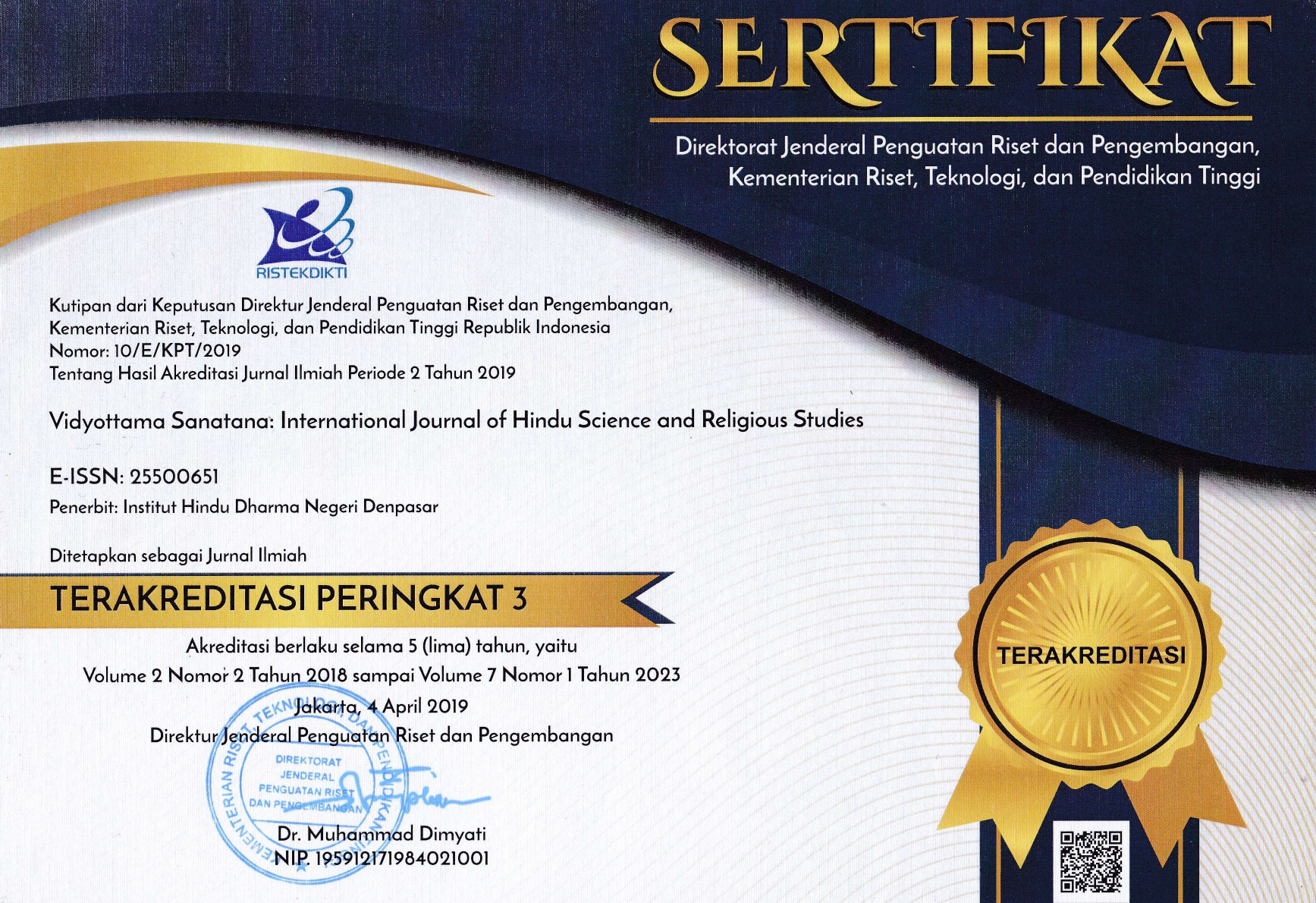HERITAGE TOURISM BASED ON HINDU THEOLOGY AT CANDI TEBING GUNUNG KAWI TAMPAKSIRING VILLAGE GIANYAR REGENCY
DOI:
https://doi.org/10.25078/vidyottama.v6i2.1677Keywords:
Heritage Tourism, Tourism Management, Destination of Candi Gunung KawiAbstract
Heritage Tourism constitutes an antithesis with mass tourism which is based on the number of tourist arrivals to Bali, so that the existence of archeology at Gianyar regency has not yet been packaged maximum by tourism stakeholders with aiming to get quality tourists for long stay guests at cultural heritage. This phenomenon is a problem in line with tourism sustainable development based on archeology remains. Heritage tourism based on Hindu Theology at Candi Tebing Gunung Kawi is interestingly to be researched to find out its implications towards the preservation of Candi Gunung Kawi as a holy place to pray ancestors and Ida Sang Hyang Widhi Wasa. Qualitative method is implemented in this research with problem’s formulation : (1) What is the exsistency Candi Tebing Gunung Kawi as heritage tourism at Tampaksiring Village Gianyar Regency, (2) How to manage the heritage tourism at Tampaksiring Gianyar Regency based on Hindu Theology, (3) The Implication of Heritage Tourim towards the living of Hindu Religion development at Tampaksiring village. Teories are applied: (1) Religius Theory, (2) Tourism Management Theory, (3) Symbolic Interactionalisme Theory. Collecting data by. Observation, interview, library study with analysis of Qualitative Descriptive. The Findings of this research are: Religious study has been implemented, Tourism Management Theory (Wahab, 2013) has been matched with archeology criteria, it has been proven metamorphosis of 11th Bali Cultures can be packaged as heritage tourism.
References
Ardika, I Wayan et al. 1993. Dampak pariwisata terhadap situs dan peninggalan
Arkeologi di Bali. Laporan Penelitian. Denpasar: Universitas Udayana.
Aas, C., Ladkin, A., dan Fletcher, J., 2005. Stakeholder Collaboration And Heritage
Management. Annals of Tourism Research, Vol.32.No.1, hal 28-48.
Bernet Kempers A.J. Monumental Bali, Introduction to Balinese Archaeology
Guide to the Monuments. Periplus, 1991.
Gunawarman, AA Gr. 2013. Perhitungan Proporsi Pada Candi Tebing Gunung
Kawi di Tampaksiring-Gianyar. Tesis. Udayana Press
Laksmi, Ni Ketut Puji Astiti. 2017. Identitas Keberagamaan Masyarakat Bali Kuno
Pada Abad IX-XIV Masehi: Kajian Epigrafis. (Disertasi).
Jakarta: Universitas Indonesia.
Moleong, Lexy J. 2007. Metodologi Penelitian Kualitatif. Bandung : PT. Remaja Rosdakarya.
Terry,G.R, 2008, Prinsip-Prinsip Manajemen
Wahab, Salah.2003. Manajemen Kepariwisataan. PT. Pradnya Paramita Jakarta
Heritage Of Nusantara: International Journal Of Religious Literature And Heritage, 9(2), 19. https://heritage.kemenag.go.id/index.php/heritage/article/view/550/354
Wulandari, A. A. I. D., Mandra, I. W., & Sentana, G. D. D. (2019). Nilai-Nilai Pendidikan Agama Hindu Yang Terkandung Dalam Geguritan Lubdaka. Jurnal Penelitian Agama Hindu, 3(4), 265–269. http://jayapanguspress.penerbit.org/index.php/JPAH
Yendra, I. W. (2007). Kanda Empat Sari: Sakti Tanpa Guru (1st ed.). Paramita.
Yendra, I. W. (2009). Kanda Empat Dewa: Manusia Setengah Dewa Sakti Manderaguna (Pertama). Paramita.


















